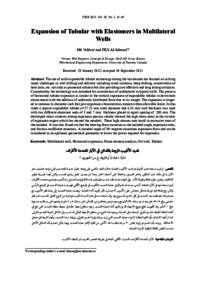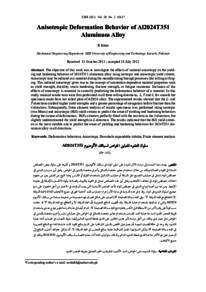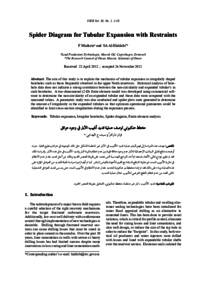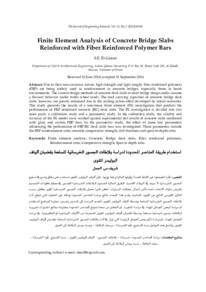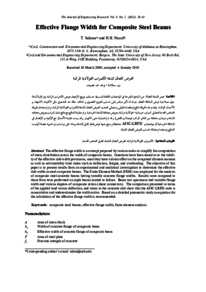وثيقة
Expansion of tubular with elastomers in multilateral wells.
المساهمون
Al-Jahwari, F. K. S., مؤلف
الناشر
Sultan Qaboos University
ميلادي
2013
اللغة
الأنجليزية
الملخص الإنجليزي
The use of solid expandable tubular technology during the last decade has focused on solving many challenges in well drilling and delivery including zonal isolation, deep drilling, conservation of hole sizes, etc. not only as pioneered solution but also providing cost effective and long lasting solutions. Concurrently, the technology was extended for construction of multilateral in typical wells. The process of horizontal tubular expansion is similar to the vertical expansion of expandable tubular in down-hole environment with the addition of uniformly distributed force due to its weight. The expansion is targeted to increase its diameter such that post expansion characteristics remain within allowable limits. In this study a typical expandable tubular of 57.15 mm outer diameter and 6.35 mm wall thickness was used with two different elastomer seals of 5 and 7 mm thickness placed at equal spacing of 200 mm. The developed stress contours during expansion process clearly showed the high stress areas in the vicinity of expansion region which lies around the mandrel. These high stresses may result in excessive wear of the mandrel. It was also found out that the drawing force increases as the mandrel angle, expansion ratio, and friction coefficient increases. A mandrel angle of 20o requires minimum expansion force and can be considered as an optimum geometrical parameter to lower the power required for expansion.
المجموعة
ISSN
1726-6742
URL المصدر
zcustom_txt_2
Velden, M. D., & Al-Jahwari, F. K. S. (2013). Expansion of tubular with elastomers in multilateral wells. The Journal of Engineering Research, 10 (1), 41-49.
الملخص العربي
تركزت استخدامات تكنولوجيا تمديد الأنابيب الصلبة خلال العقد الماضي على إيجاد حلول عديدة للتحديات التي تواجه عمليات حفر الآبار بما في ذلك عزل المناطق، والحفر العميق، والحفاظ على أحجام الحفر. وهذا لم يحدث كحل ريادي فحسب ولكن أيضا كوسيلة لتوفير التكاليف وتقديم حلول فعالة وطويلة الأمد. وفي الوقت نفسة، فقد امتدت تطبيقات هذه التكنولوجيا لتشمل بناء أنابيب بتصاميم متعددة الأطراف ليتم استخدامها في الآبار المعتادة. أما من حيث نمذجة وتحليل عملية التمديد للأنابيب في الوضع الأفقي فهو يشبه عملية التمديد في الوضع الرأسي ولكن مع إضافة قوة موزعة بشكل متجانس على الأنبوب لاحتساب تأثير الوزن أثناء العملية. وتهدف عملية التمديد إلى زيادة قطر الأنبوب مع ضمان بقاء خصائصه بعد التمديد في ظل الحدود المسموح بها. وقد استخدمت في هذه الدراسة أنابيب نموذجية من النوع القابل للتمديد ذات قطر خارجي يبلغ 57.15 ملم وجدار ذو سمك 6.35 ملم مع وجود نوعين مختلفين من اللدائن ذات سمك 5 و 7 ملم تم وضعها على مسافات متساوية تبلغ 200 ملم. وقد أظهرت نتائج توزيع الإجهاد الذي تكون أثناء عملية التمديد وجود مناطق إجهاد عالية في محيط منطقة التمديد التي تقع في أنحاء المنطقة المحيطة بالجسم المغزلي المستخدم في العملية. ووجود هذا النوع من مناطق الإجهاد العالي قد تتسبب في التآكل المفرط للجسم المغزلي. كما تم أيضا اكتشاف بأن القوة المتطلبة لإجراء عملية التمديد التي تزيد بزيادة زاوية الجسم المغزلي، وزيادة نسبة التمديد، وأيضا الزيادة في معامل الاحتكاك. ووجد بأن الجسم ذو زاوية بمقاس 20 درجة يتطلب الحد الأدنى من القوة لإتمام عملية التمديد وبهذا يمكن اعتباره بأنه الشكل الأمثل هندسيا لخفض الطاقة المطلوبة لإجراء العملية.
قالب العنصر
مقالات الدوريات

